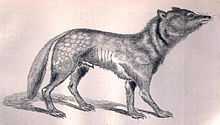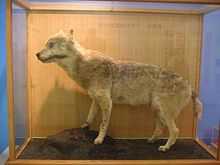Honshu wolf
| Honshū wolf | |
|---|---|
 | |
| Taxidermied specimen, at the National Museum of Nature and Science, Tokyo, Japan | |
| Conservation status | |
| Extinct (1905) | |
| Scientific classification | |
| Kingdom: | Animalia |
| Phylum: | Chordata |
| Class: | Mammalia |
| Order: | Carnivora |
| Family: | Canidae |
| Genus: | Canis |
| Species: | C. lupus |
| Trinomial name | |
| Canis lupus hodophilax (Temminck, 1839) | |
| Subspecies | |
|
*Canis lupus hattai | |
| Synonyms | |
| |
The Honshū wolf (Canis lupus hodophilax), known in Japan as the Japanese wolf (ニホンオオカミ(日本狼) Nihon Ōkami), yamainu (ヤマイヌ(豺、犲、山犬), "mountain dog"), or simply wolf (オオカミ(狼) Ōkami), is one of the two extinct subspecies of the gray wolf once endemic to the islands of Japan. The Honshū wolf occupied the islands of Honshū, Shikoku, and Kyūshū in Japan. The other subspecies was the Hokkaidō wolf, native to the island of Hokkaidō.
History

Honshū wolves, the smaller descendants of gray wolves, were plentiful in the country of Japan. They were the smallest known wild subspecies of Canis lupus; they measured about 35 inches (90 cm) long and 12 inches (30 cm) inches at the shoulder.[2] Their population began to decrease in 1732 when rabies, first reported in Kyūshū and Shikoku, was introduced to the area they inhabited. It affected different wolf populations all through the nineteenth century. Most argue that it was humans that brought the virus to Japan, trying to kill the wolves on purpose. It is also believed that local domestic dogs in the regions may have transported the disease. Either way, along with intense human persecution, the wolves proceeded into extinction.[2][3] The last known specimen died in 1905, in Nara Prefecture.
Some interpretations of the Honshū wolf's extinction stress the change in local perceptions of the animal: rabies-induced aggression and deforestation of the wolf's habitat forced them into conflict with humans, and this led to them being targeted by farmers.[4]
Other sources say the wolves were killed off as a national policy.[5]
There are currently eight known pelts and five stuffed specimens of the Japanese wolf in existence. One stuffed specimen is in the Netherlands, three are in Japan, and the animal caught in 1905 is kept in the British Museum. Owing to its small size the Honshū wolf's classification as a subspecies of the gray wolf is disputed.
The wolf was afforded a benign place in Japanese folklore and religious traditions: the clan leader Fujiwara no Hidehira was said to have been raised by wolves, and the wolf is often symbolically linked with mountain kami in Shinto. The most famous example is the wolf kami of Mitsumine Shrine in the town of Chichibu in Saitama Prefecture.
Sightings of the Japanese wolf have been claimed from the time of its extinction to the present day, but none of these have been verified[6] (see cryptozoology).[7]
Physical characteristics

The Honshū wolf was the world’s smallest known wolf. From nose to tail, it grew to about 35 inches in length and stood about a foot tall. It was said that the Honshū wolf much more closely resembled dogs, coyotes and jackals than its Siberian wolf ancestors due to their short wiry hair and a thin dog-like tail that was rounded at the end, along with their short legs. Therefore, the Honshu wolf is argued to be its own species instead of being a gray wolf subspecies because of these physical differences.[3]
Diet
The Honshū Wolf was known to eat animals much larger than it, including deer and wild boar. Farmers appreciated their appetite for smaller animals such as rodents and hares, which reduced the number of farm pests.[8] The specialized, strictly carnivorous diet was one of the many reasons the Honshū Wolf became extinct. As wolf populations increased, they required more of their exclusive diet to maintain their numbers, which could not be sustained by the local fauna.
Extinction

Honshu wolves were abundant in Japan until 1732 when rabies was introduced to the island. It was rabies, deforestation of the wolf's habitat, and conflict with humans that led to their extinction. The last specimen was officially killed in 1905 in Nara prefecture. Although there have been many sightings claimed since then, none of them have been verified. There are five known mounted specimens: three in Japan, one in the Netherlands, and the last officially killed specimen in the British Museum.
Culture

The Honshu wolf is a prominent figure in Japanese folklore and culture. The mountains of Japan, seen as a dangerous, deadly place, are highly associated with the wolf. The Honshu wolf is believed to be the protector and guardian of the mountains, where it resides in its most remote parts. Many mountain villages, such as Okami’iwa (Wolf Rock) and Okamitaira (Wolf Plateau), are named after the wolf; this could be due to a sighting at the location, or a simple homage to the species.[4] Sightings of the Honshu wolf were very rare, and the wolf was described as being more of a spirit entity protecting travelers. Some legends bring this to a whole new level, where abandoned infants are found and raised by the wolves. The wolves also protect surrounding villages from the dangerous wildlife.[2] The spirit form of the Japanese wolf, which has been worshiped since ancient times, is called makami (真神). It understands human speech, rewards good, and punishes evil. Makami shrines are found in Saitama, Shizuoka, and Tokyo.
Some villages have wolf charms called shishiyoke, that protected their village and their crops against wild boar. In addition, other protective shrines can be found in many villages, especially on the Kii Peninsula. In some villages, such as in Gifu prefecture, the skull of the wolf was used as the charm for both protection as well as curing possessed villagers. In addition to protecting the crops, the wolf may leave prey for villagers.[4] A tradition called inu no ubumimai consists of giving a mother Honshu wolf rice when she gives birth to a cub. In return, the wolf would protect the village and assist in danger, or leave the village in times of famine.[2]
Some legends portray the Honshu wolf as being prophetic creatures. In the Tamaki Mountains the location of a tree called “the cypress of dog-howls” is said to be the site where wolves howled before a flood in 1889, warning the villagers.[4] The Honshu wolf was not commonly killed by villagers, and attacks were rare. Some folklore states that the killer of a Honshu wolf faced punishment from the spiritual world. Legends also describes the wolf as being concealed by the environment, and that its fur changes with the seasons to further camouflage itself. In many local cultures, therefore, the Honshu wolf is believed not to be extinct; it was always difficult to find.[2]
References
| Wikispecies has information related to: Canis lupus hodophilax |
| Wikimedia Commons has media related to Canis lupus hodophilax. |
- ↑ Wozencraft, W. C. (2005). "Order Carnivora". In Wilson, D. E.; Reeder, D. M. Mammal Species of the World (3rd ed.). Johns Hopkins University Press. ISBN 978-0-8018-8221-0. OCLC 62265494.
- ↑ 2.0 2.1 2.2 2.3 2.4 "Lost Wolves of Japan". SciLogs. Retrieved 23 October 2012.
- ↑ 3.0 3.1 "The Honshu Wolf". Bib.ge. Retrieved 23 October 2012.
- ↑ 4.0 4.1 4.2 4.3 Knight, John (1997). "On the Extinction of the Japanese Wolf". Asian Folklore Studies (Nanzan University) 56 (1): 129–159. Retrieved January 24, 2014. Stable URL: http://www.jstor.org/stable/1178791
- ↑ Chester Dawson (December 28, 2012). "If the Japanese Diet Included Deer, It Might Keep Wolves From the Door". Wall Street Journal.
- ↑ Shuker, Karl P. N. (2003). The beasts that hide from man: seeking the world's last undiscovered animals. New York: Paraview Press. ISBN 1-931044-64-3.
- ↑ Hall, Jamie (2005). "The Cryptid Zoo: Japanese Dwarf Wolf (or Shamanu)". Retrieved 2006-06-15.
- ↑ "Honshu Wolf". Cosmosmith. Retrieved 23 October 2012.
Sources
- Knight, John (1997). "On the Extinction of the Japanese Wolf". Asian Folklore Studies (Nanzan University) 56 (1): 129–159. Retrieved January 24, 2014. Stable URL: http://www.jstor.org/stable/1178791
- >Shuker, Karl P. N. (2003). The beasts that hide from man: seeking the world's last undiscovered animals. New York: Paraview Press. ISBN 1-931044-64-3.
| |||||||||||||
| ||||||||||||||||||||